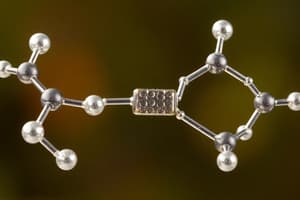Podcast
Questions and Answers
Which factor primarily influences the conductivity of a coordination compound?
Which factor primarily influences the conductivity of a coordination compound?
- The size of the ligand.
- The number and charge of the ions in solution. (correct)
- The molecular weight of the compound.
- The temperature of the solution.
How are ligands classified?
How are ligands classified?
- Based on their molecular weight.
- By their charge and bonding capability. (correct)
- According to their size relative to the central atom.
- By the temperature at which they bond.
Which type of electrolyte refers to a coordination compound that produces three ions of both the complex and the counter ion?
Which type of electrolyte refers to a coordination compound that produces three ions of both the complex and the counter ion?
- 4:4 electrolyte.
- 3:3 electrolyte. (correct)
- 1:1 electrolyte.
- 2:2 electrolyte.
Which statement best describes the role of ligands in coordination compounds?
Which statement best describes the role of ligands in coordination compounds?
What does the term 'polydentate ligand' refer to?
What does the term 'polydentate ligand' refer to?
Which of the following statements is NOT true about double salts?
Which of the following statements is NOT true about double salts?
What is the minimum number of donor atoms a bidentate ligand must possess?
What is the minimum number of donor atoms a bidentate ligand must possess?
What determines the primary valence of a central metal ion in a coordination compound?
What determines the primary valence of a central metal ion in a coordination compound?
How is the secondary valence of a metal ion defined in coordination compounds?
How is the secondary valence of a metal ion defined in coordination compounds?
What happens to coordination compounds upon dissociation in solution?
What happens to coordination compounds upon dissociation in solution?
When silver nitrate is added to a coordination compound containing chloride ions, what is formed?
When silver nitrate is added to a coordination compound containing chloride ions, what is formed?
In the coordination compound K4[Fe(CN)6], what is the primary valence of the iron (Fe)?
In the coordination compound K4[Fe(CN)6], what is the primary valence of the iron (Fe)?
Which type of ligand donates only one electron pair to the central metal atom?
Which type of ligand donates only one electron pair to the central metal atom?
What is the typical coordination number for many coordination compounds?
What is the typical coordination number for many coordination compounds?
Which ligand type can donate two electron pairs to the central metal ion?
Which ligand type can donate two electron pairs to the central metal ion?
Flashcards
Primary Valence
Primary Valence
The charge on the central metal ion in a coordination compound, determined by its oxidation number.
Secondary Valence
Secondary Valence
The coordination number of a metal ion; the number of ligands directly attached to the central metal atom.
Coordination Compound
Coordination Compound
A compound where a central metal ion is bonded to surrounding molecules or ions (ligands).
Ligand
Ligand
Signup and view all the flashcards
Monodentate ligand
Monodentate ligand
Signup and view all the flashcards
Bidentate ligand
Bidentate ligand
Signup and view all the flashcards
Coordination Number
Coordination Number
Signup and view all the flashcards
Reaction with Silver Nitrate
Reaction with Silver Nitrate
Signup and view all the flashcards
Coordination Compound
Coordination Compound
Signup and view all the flashcards
Ligand
Ligand
Signup and view all the flashcards
Polydentate Ligand
Polydentate Ligand
Signup and view all the flashcards
Double Salt
Double Salt
Signup and view all the flashcards
Complex Compound
Complex Compound
Signup and view all the flashcards
Conductivity of Coordination Compounds
Conductivity of Coordination Compounds
Signup and view all the flashcards
1:1, 2:2, 3:3 Electrolyte
1:1, 2:2, 3:3 Electrolyte
Signup and view all the flashcards
AgCl precipitate
AgCl precipitate
Signup and view all the flashcards
Study Notes
Coordination Compound Conductivity
- The nature of the ligands plays a key role in determining the conductivity of a coordination compound.
Ligand Classification
- Ligands are classified based on the number of donor atoms they possess:
- Monodentate ligands donate one electron pair to the central metal atom.
- Bidentate ligands donate two electron pairs to the central metal atom.
- Polydentate ligands donate more than two electron pairs to the central metal atom.
Electrolyte Types
- A coordination compound that produces three ions of both the complex and the counter ion is classified as a 3:3 electrolyte.
Ligand Role
- Ligands in coordination compounds act as electron pair donors, forming coordinate covalent bonds with the central metal atom.
Polydentate Ligands
- Polydentate ligands are ligands that can bind to a central metal atom through multiple donor atoms.
Double Salts
- Double salts do NOT contain a complex ion.
Bidentate Ligands
- Bidentate ligands must possess a minimum of two donor atoms to bind to the central metal atom.
Primary Valence
- The primary valence of a central metal ion in a coordination compound is determined by its oxidation state.
Secondary Valence
- The secondary valence of a metal ion in coordination compounds refers to the number of ligands attached to the central metal atom.
Coordination Compound Dissociation
- Coordination compounds dissociate in solution into their constituent ions, with the complex ion remaining as a single unit.
Silver Nitrate Reaction
- When silver nitrate is added to a coordination compound containing chloride ions, a white precipitate of silver chloride (AgCl) is formed.
Primary Valence in K4[Fe(CN)6]
- In the coordination compound K4[Fe(CN)6], the primary valence of the iron (Fe) is +2.
Monodentate Ligands
- Monodentate ligands are ligands that donate only one electron pair to the central metal atom.
Coordination Number
- The typical coordination number for many coordination compounds is 4 or 6.
Bidentate Ligands
- Bidentate ligands can donate two electron pairs to the central metal ion.
Studying That Suits You
Use AI to generate personalized quizzes and flashcards to suit your learning preferences.




